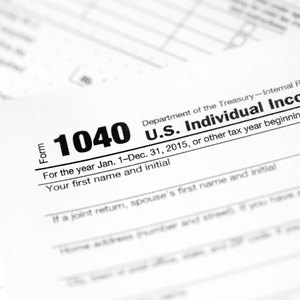
If you don’t report your 401(k) contributions correctly on your income tax return each year, you might miss some valuable tax-savings opportunities. When using Form 1040 to file your taxes, you have several options for reporting your retirement contributions based on different factors. Reviewing how to correctly report these retirement payments when filing your taxes will help you get all of the benefits to which you’re entitled.
What Is a 1040 Form?
Form 1040 is the basic form most individuals, entrepreneurs and small-business owners use to file their taxes. Whether you're an employee of a company, a gig worker, a contractor, a freelancer, a 1099 vendor, a solopreneur or you have a side hustle, this is the form you will most likely use.
You can download the form from the IRS website or request a tax booklet that provides instructions, a Form 1040 and other forms you might need. However, you should always get advice from a tax adviser when you file your income taxes each year unless you feel certain you know exactly what you’re doing.
What Type of Retirement Contribution?
Where you report your retirement contribution will depend on what type of contribution you make. Common retirement accounts include a pension, a 401(k) and different individual retirement accounts (IRA).
With a traditional 401(k) or traditional IRA, you don’t pay taxes on those amounts when you make your contribution (you pay taxes when you withdraw money from these pre-tax accounts). You don’t report 401(k) contributions for a deduction on your 1040, but you can get a deduction for traditional IRA contributions. You can't get any deduction for a Roth IRA or similar after-tax accounts since these contributions are from post-tax dollars.
Schedule 1 of Form 1040
Where do traditional IRA contributions go on a 1040? If you are claiming traditional IRA deductions, you’ll report them on line 20 of Schedule 1 of Form 1040. You will want to work with a tax adviser because factors such as your filing status, income and participation in an employer-sponsored retirement plan contributions can affect how much you can deduct.
If you are making contributions and disbursements in the same year, for example, you’ll also need to make sure you report this correctly.
Line 1 of Form 8606
If you've made traditional IRA contributions that you're not qualified to deduct, that will affect how you report these retirement contributions and will require you to use an additional form. You will report your nondeductible traditional IRA contributions on line 1 of Form 8606 of Form 1040. Again, make sure to get advice from a tax adviser when reporting retirement contributions like this.
Line 19 of Schedule C
If you are a small-business owner, you might have set up special retirement contributions for yourself and/or your employees (which might just be a spouse or children). If so, you’ll claim these contributions as business expenses on Schedule C of your 1040 form. This not only helps you reduce your taxable income (by decreasing your profits for the year), but it can also help you lower your payroll taxes.
Know Your Limits and Credits
You should stay updated with how much you can contribute to your specific retirement plan every year since this depends on the plan type and tax year. For example, you can contribute $6,000 to a traditional IRA in 2022 ($7,000 if you’re age 50 or older). The contribution limits are higher with a 401(k) or an employer-sponsored SIMPLE IRA, explains 1040.com, but you can't deduct these kinds of contributions.
References
Writer Bio
Steve Milano has written more than 1,000 pieces of personal finance and frugal living articles for dozens of websites, including Motley Fool, Zacks, Bankrate, Quickbooks, SmartyCents, Knew Money, Don't Waste Your Money and Credit Card Ideas, as well as his own websites.

